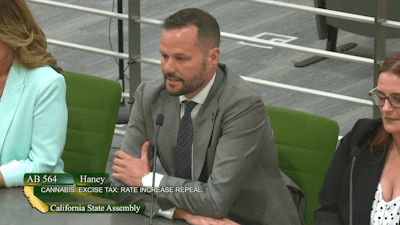
California lawmakers stood united behind extending a lifeline to the state’s floundering cannabis industry when they unanimously advanced legislation on April 22 to cancel an excise tax increase on dispensary sales.
Despite heated opposition from cannabis tax revenue beneficiaries, the state’s Assembly Business and Professions Committee voted, 15-0, to support Assembly Bill 564. During Tuesday’s hearing, supporters emphasized that the legislation would merely freeze the state’s current 15% excise tax rate, not cut taxes.
Without A.B. 564, sponsored by Matt Haney, D-San Francisco, the California Department of Tax and Fee Administration (CDTFA) would be required under 2022 legislation orchestrated by Gov. Gavin Newson to jack the excise tax rate to 19% on July 1, 2025, representing a 27% increase on an already overtaxed marketplace.
In addition to the excise tax, cannabis retailers are also on the hook for remitting up to a 10.75% state sales tax and up to a 10% local sales tax in cities like Los Angeles, San Diego and San Jose.
Haney called the forthcoming excise tax hike an “extinction event” for the state’s licensed cannabis operators.
“The legal cannabis industry needs a lifeline to keep small businesses open, to keep hundreds of thousands of workers employed and keep the promise we made to voters to make cannabis legal and accessible,” Haney said during Tuesday’s hearing.
California’s licensed retail footprint has flatlined at roughly 1,225 active stores since mid-2023, as 57% of the state’s cities and counties still prohibit cannabis dispensaries, according to the California Department of Cannabis Control (DCC).
In addition, California led the nation with 12,600 cannabis jobs lost in 2023 and 5,000 cannabis jobs lost in 2024, according to industry employment agency Vangst.
“California has always been at the heart of America’s cannabis economy and culture, but since voters passed Prop. 64, California has not given the legal cannabis industry a chance to grow in its potential,” Haney said. “The legal cannabis industry, which is subject to state and local taxes and fees, is constantly at threat of being overtaken by the illegal, untaxed industry.”
Haney pointed to a March 2025 economic report commissioned by the DCC that estimated 38% of cannabis consumed by Californians in 2024 came from licensed sources, while the majority came from unregulated and untaxed sources. “This means California is missing out on millions in lost potential revenue from illicit, untaxed sales,” he said.
Testifying in support of A.B. 564, Caren Woodson, who serves on the board of the California Cannabis Industry Association, told lawmakers not to confuse “survival with stability” when considering whether operators can withstand a tax hike. Woodson is also the senior director of compliance and licensing for Kiva Brands Inc.
Woodson mentioned the recent collapses of large California operators like Flow Cannabis Co., Herbl, MedMen, High Times, Statehouse Holdings, Gold Flora and Grassdoor.
“I can tell you from experience, even remaining category leaders like Kiva are not immune,” she said. “We’ve experienced three consecutive reductions in force since 2022. If companies with investment expertise, scale and brand power are folding, what hope is there for a mom-and-pop operator or for social equity licensees? Those businesses are disappearing quietly without press releases or receiverships—just more consolidated storefronts, more empty warehouses and more dreams deferred.”
Woodson also mentioned another threat facing cannabis businesses: tariffs.
RELATED: High Tariffs Hurting Cannabis Sector, With Little Relief in Sight
From packaging to hardware, machinery and compost, every sector of the cannabis supply chain is facing inflationary pressure, she said.
“New tariffs and a tax increase?” Woodson said. “Those on the brink won’t survive. Squeezing more from the remaining 40% in the market won’t generate new revenues; it will shrink them. Every minute we spend debating tax increases is a minute we’re not spending on solutions that matter, like expanding retail access, strengthening enforcement and bringing consumers to the legal market."
Amid California’s industry hardships, the CDTFA reported $219 million in total cannabis tax revenue from the fourth quarter of 2024—including $127.8 million from excise taxes—the lowest-generating quarter since Q1 of 2020. The tax agency has yet to report the first quarter of 2025.
In addition, the state’s licensed cannabis retailers reported $1.08 billion in sales for the first quarter of 2025, representing a 23% decrease from a market peak in the second quarter of 2021, according to the DCC.
While those in support of A.B. 564 argued that raising the excise tax would only drive consumers out of the licensed market and therefore shrink state revenue, those whose organizations are on the receiving end of the excise tax revenue opposed the bill during the April 22 committee hearing.
Tona M. Pena, the manager of tribal programs and advocacy at Youth Forward, one of two primary testifiers in opposition of the bill, told committee members that she was representing 98 youth and environmental organizations that depend on cannabis tax revenue.
“I’m here today to urge you to prioritize funding for children, youth and the environment over the cannabis industry,” she said. “Youth organizations in rural and urban communities are the hardest hit by the war on drugs, including tribal organizations and nations.”
Pena said tribal nations throughout Northern California and the Central Valley have suffered for decades from cannabis cultivators polluting waterways and creating “toxic waste dumps” on their lands. Those environmental compliance issues, however, primarily involve unlicensed operations, not those regulated by the DCC.
Heidi Keiser, the director of government affairs at Child Action Inc., an organization that supports family and child care providers in Sacramento, also testified in opposition.
“The revenues derived from the cannabis excise and cultivation taxes represent a crucial funding stream for child care slots needed by families with lower incomes,” she said. “Here in Sacramento County, no fewer than 4,000 children are still on our wait list, urgently awaiting a child care slot.”
These child care programs and youth groups, along with environmental programs, law and justice organizations, and drug treatment and prevention centers, are among the Tier 3 recipients of California’s cannabis excise tax revenue that Newsom struck a deal with in 2022.
Rather than providing these organizations a more stable form of funding, the governor orchestrated a state budget in 2022 that triggered the cannabis excise tax rate increase on July 1, 2025, should the excise tax revenue fall below a baseline of $680 million annually for three years. The shrinking excise tax revenue has yet to hit that benchmark.
Committee Chairman Marc Berman, D-Menlo Park, said that while he wasn’t an assemblymember when voters approved citizen-initiated Proposition 64 in the November 2016 election, he finds the current Tier 3 funding conflict “frustrating” and “unfortunate.”
“I wish they didn’t put it together the way they did because we should be funding fantastic community organizations in the budget,” he said. “We should be funding them philanthropically. I personally don’t love tying it to other things, because then when those other things struggle and we need to make changes to what our approach was going to be and what the promise was, then it negatively impacts the great organizations that are here today and that spoke in opposition to the bill, because we’re not giving them the funding that they were promised that they thought they were going to get.”
Berman also recognized that California’s budget challenge won’t fix itself while the Trump administration “slashes funding” for programs such as organizations that make up the state’s Tier 3 entities.
Despite the funding troubles, the committee chairman indicated that taxing California’s cannabis industry to death serves nobody.
“We’re committed to making sure that our communities have the resources that they need while doing what’s necessary to ensure a cannabis industry still exists to tax in the first place,” he said.
























